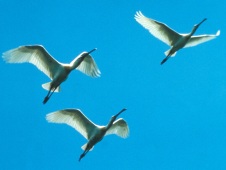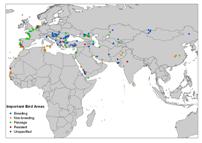
Eurasian Spoonbill Platalea leucorodia is a colonial waterbird ranging from western Europe to China and northern Africa; the northern populations are migratory while those in the south are largely resident. Globally, 175 Important Bird and Biodiversity Areas have been identified for this species covering populations during the breeding season, when on passage and in non-breeding areas.

Some species, many of them migratory, congregate seasonally in large numbers at particular sites. These sites are critical to their conservation and need to be protected as a network; often individuals move between them using different sites at different times of year. For example, Eurasian Spoonbill Platalea leucorodia is a colonial species of extensive shallow marshes, rivers and flooded areas and, especially in the non-breeding season, of sheltered marine habitats such as tidal creeks and lagoons. It usually breeds on islands in lakes and rivers and has a wide distribution, ranging from western Europe to China and north and north-east Africa. The northern populations are migratory, most spending the non-breeding season in flocks in western and eastern Africa and south-east China. In the southern parts of its range birds are largely resident, and populations in these regions may be joined during the northern winter by migrant birds.
Globally, 175 Important Bird and Biodiversity Areas (IBAs) have been identified where numbers of P. leucorodia regularly exceed IBA selection thresholds in either the breeding season, when on passage or during the non-breeding season (analysis of data held in BirdLife’s World Bird Database 2008). As a whole, these IBAs form a vast yet conservable network of key sites for this species throughout its range, covering all stages of its annual cycle.
Related Species
Compiled: 2004 Last updated: 2008
Recommended Citation:
BirdLife International (2008)
Important Bird Areas for congregatory species: Eurasian Spoonbill.
Downloaded from https://datazone.birdlife.org/sowb/casestudy/important-bird-areas-for-congregatory-species:-eurasian-spoonbill on 01/02/2025